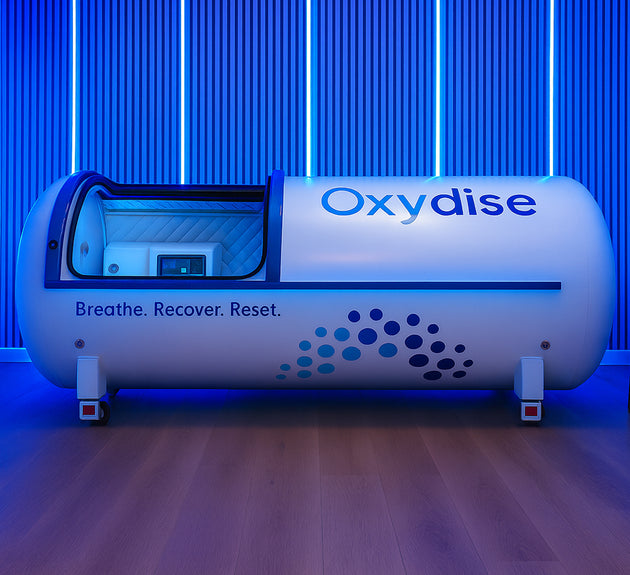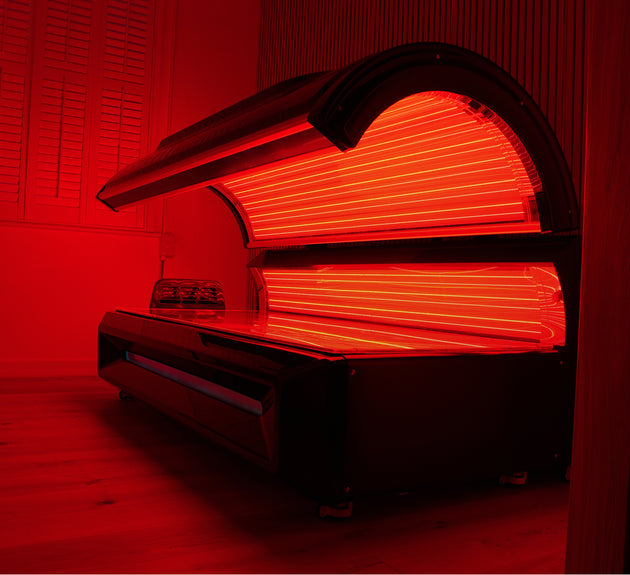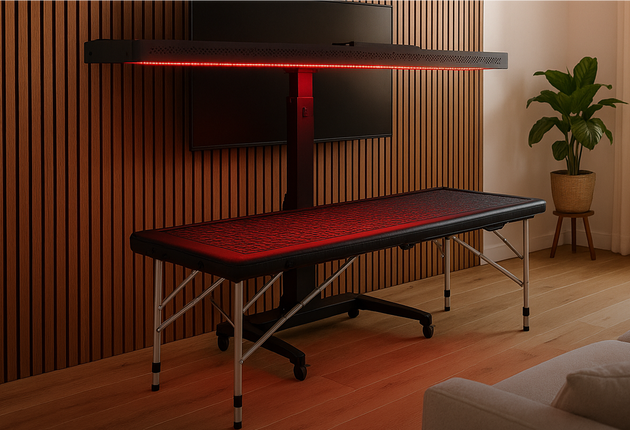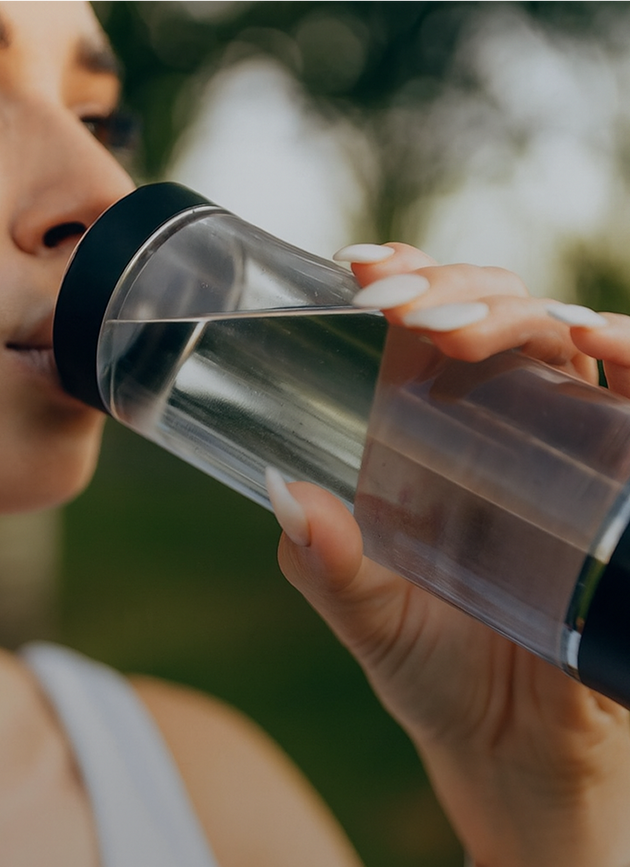A simple framework to feel better, recover faster, and perform at your best.
- Health is a system — small, consistent gains across many areas beat big gains in one.
- Start with sleep, nutrition, and movement; layer in stress control, sunlight, and social connection.
- Advanced tools like HBOT or Red Light Therapy can be powerful, but only when built on solid daily habits.
1. Nutrition
Why it matters
Food is the foundation of health. It fuels your cells, builds your hormones, supports your immune system, and keeps inflammation in check. A colourful, unprocessed diet improves everything from your mood to your metabolism.
Do this
- Build plates around real food: half vegetables, a quarter protein, a quarter whole carbs.
- Aim for a palm-sized serving of protein at every meal.
- Choose whole grains, good fats (olive oil, avocado, nuts), and plenty of colour.
- Avoid ultra-processed foods, sugary drinks, and excessive refined carbs.
- Stay consistent — the small choices add up.
Enhancement (optional)
If your diet is mostly on point, you can optimise further:
- Add a quality omega-3 supplement for inflammation control.
- Use probiotics or fermented foods for gut health.
- For energy and cellular repair, Red Light Therapy and HBOT are being researched as potential complements to a nutrient-rich diet.
Quick win: Eat a protein- and fibre-rich breakfast tomorrow.
Fun fact: Spices like turmeric and cinnamon contain powerful plant compounds that switch off inflammatory signals in your body.
2. Hydration
Why it matters
Water makes up about 60% of your body. It powers digestion, regulates temperature, keeps your brain sharp, and helps flush out waste. Even mild dehydration can affect focus and performance.
Do this
- Drink around 2–3 litres of water daily (more if you’re active).
- Sip regularly rather than guzzling at once.
- Check your urine — pale yellow means you’re good.
- Add electrolytes if you sweat heavily.
- Limit sugary drinks, excess caffeine, and alcohol.
Enhancement (optional)
Try hydrogen-rich water or mineral drops if you use filtered water that’s lost natural minerals.
Coconut water or a pinch of sea salt in your bottle can also help maintain electrolyte balance.
Quick win: Have a glass of water before every coffee.
Fun fact: Your brain is roughly 75% water — being dehydrated by just 2% can impair memory and concentration.
3. Movement
Why it matters
Exercise keeps your heart strong, muscles active, and metabolism flexible. It also releases endorphins — natural feel-good chemicals that lower stress and improve mood.
Do this
- Move most days. Aim for 150 minutes of moderate exercise weekly.
- Mix cardio (walking, cycling, swimming) with strength training.
- Stand, stretch, or walk every hour if you work at a desk.
- Include one or two rest days to recover properly.
Enhancement (optional)
For faster recovery, try sauna sessions or cold plunges after intense exercise — both help with circulation and inflammation.
Red Light Therapy can be useful post-training to support muscle repair and reduce soreness.
Quick win: Take a brisk 10-minute walk after meals.
Fun fact: Your muscles release signalling proteins during exercise called myokines that talk to your brain and immune system.
4. Sleep
Why it matters
Sleep is when your body heals, hormones rebalance, and your brain resets. Chronic sleep loss affects everything — metabolism, mood, focus, immunity, and long-term health.
Do this
- Aim for 7–9 hours nightly.
- Keep consistent sleep and wake times, even on weekends.
- Dark, cool, quiet bedroom = better sleep.
- Avoid screens and bright light for 60 minutes before bed.
- Skip caffeine after 2 p.m.
Enhancement (optional)
For relaxation and better melatonin release, use red or warm lighting in the evening instead of bright white or blue light.
A magnesium glycinate supplement can also promote deeper sleep.
If you struggle with recovery-related insomnia, Red Light Therapy is being studied for its potential benefits on sleep quality.
Quick win: Charge your phone outside your bedroom tonight.
Fun fact: During deep sleep, your brain flushes out waste via the “glymphatic system” — your body’s built-in overnight cleaning crew.
5. Stress & Mental Well-Being
Why it matters
Stress isn’t always bad — short bursts sharpen focus — but chronic stress drives inflammation, anxiety, poor sleep, and low energy.
Do this
- Practise relaxation: deep breathing, meditation, or yoga.
- Spend time in nature or with people who lift you up.
- Exercise regularly — it’s one of the best stress relievers.
- Learn to say no; rest is productive.
- Get professional help if stress or anxiety feels overwhelming.
Enhancement (optional)
Breathwork (like box breathing or 4-7-8 breathing) can calm your nervous system within minutes.
Cold exposure (a cold shower or plunge) activates endorphins and resilience pathways.
Red Light Therapy is also being explored for mood and brain energy.
Quick win: Take three slow, deep breaths before you reply to your next stressful email.
Fun fact: Laughing lowers cortisol, the stress hormone — even fake laughing can do it.
6. Social Connection
Why it matters
Humans are social by nature. Connection reduces stress, improves immunity, and can literally extend your lifespan. Loneliness, by contrast, increases inflammation and health risks.
Do this
-
Schedule regular time with friends or family.
-
Join a group with shared interests or goals.
-
Call someone instead of texting occasionally.
-
Practise listening more than talking.
-
Spend time with people who energise you.
Enhancement (optional)
Volunteer work or joining a team sport can double as exercise and social connection.
If anxiety makes socialising difficult, combining breathwork and mindfulness before events can make it easier.
Quick win: Message one old friend today and plan to meet this week.
Fun fact: Studies show hugs release oxytocin — the “bonding hormone” — which lowers blood pressure and boosts mood.
7. Breathing
Why it matters
You can survive weeks without food, days without water, but only minutes without oxygen. How you breathe affects energy, focus, and stress.
Do this
-
Breathe through your nose, not your mouth.
-
Practise diaphragmatic breathing — deep and slow.
-
Sit and stand tall to open your lungs.
-
Try short breathwork sessions (like alternate nostril breathing).
Enhancement (optional)
Nasal strips at night can help if you’re a mouth breather.
For respiratory health, salt therapy (halotherapy) or steam inhalation can help clear airways.
For specific oxygen-related recovery needs, Hyperbaric Oxygen Therapy (HBOT) is being researched for its ability to support tissue oxygenation.
Quick win: Take 10 slow nasal breaths before a stressful call.
Fun fact: Your nose produces nitric oxide — a natural compound that widens blood vessels and helps oxygen reach your tissues efficiently.
8. Sunlight & Nature
Why it matters
Sunlight sets your internal clock, boosts mood, and provides vitamin D. Time outdoors lowers stress, blood pressure, and even improves creativity.
Do this
-
Get outside for 10–15 minutes of morning light.
-
Spend part of your lunch break outdoors.
-
Add plants to your home or workspace.
-
Walk barefoot on grass or sand when possible — it helps regulate stress.
Enhancement (optional)
If you live in darker climates or work indoors, try a daylight lamp in the morning.
Red Light Therapy can mimic parts of sunlight’s beneficial spectrum (without UV) and is being studied for skin, recovery, and circadian rhythm support.
Quick win: Take your morning coffee outside.
Fun fact: NASA discovered red light’s regenerative potential while studying plant growth on the Space Station.
9. Avoid Harmful Risks
Why it matters
Health isn’t only about what you add — it’s also about what you avoid. Smoking, heavy alcohol, and recreational drugs all accelerate ageing and inflammation.
Do this
-
Don’t smoke (and get help if you do).
-
Keep alcohol moderate (no more than a few drinks per week).
-
Use sun protection when needed.
-
Prioritise safety — seatbelts, helmets, and common sense.
-
Avoid exposure to toxic chemicals where possible.
Enhancement (optional)
If you’re quitting smoking or drinking, vitamin C and N-acetylcysteine (NAC) can help replenish antioxidants.
Infrared sauna sessions may also assist detoxification through increased circulation and sweating.
Quick win: Go alcohol-free during weekdays this month.
Fun fact: Your body can start repairing lung function just weeks after quitting smoking — it’s never too late to start.
10. Recovery & Healing
Why it matters
Growth happens in recovery, not in overdrive. Muscles, joints, and even your brain adapt and get stronger during rest periods.
Do this
-
Schedule rest days every week.
-
Sleep more during intense training or stressful weeks.
-
Try light “active recovery” like stretching or walking.
-
Use massage, foam rolling, or mobility work to release tension.
-
Respect pain — it’s information, not a nuisance.
Enhancement (optional)
For deeper recovery, Hyperbaric Oxygen Therapy (HBOT) and Red Light Therapy are being explored for oxygenation, inflammation control, and tissue repair.
Other effective tools include infrared sauna, Epsom salt baths, cold plunges, and meditation for mental recovery.
Quick win: Stretch or use a foam roller for 5 minutes tonight.
Fun fact: Bone and muscle tissue repair faster during deep sleep thanks to growth hormone — another reason recovery and sleep go hand in hand.
Putting It All Together
Improving your health doesn’t require perfection. Pick two pillars to focus on this week — say, sleep and movement — and make one small improvement in each.
Small steps compound quickly. Once the basics feel solid, explore the enhancements that fit your lifestyle and goals.
Advanced therapies like HBOT or Red Light Therapy can offer powerful boosts for recovery, energy, or performance — but they’re most effective when layered on a strong foundation of good habits.
Final Thought
Health isn’t luck — it’s structure.
Build your 10 pillars, strengthen them over time, and your body and mind will thank you for decades to come.
















